Drug Utilization Study on Hypertensive Patients and Assessment of Medication Adherence to Jnc-8 Guidelines in North Indian Tertiary Care Hospital: A Cross-Sectional Study
Amit Sharma*1, 2, Tanpreet Kaur Badwal2, Vishal Gupta3, Mahendra Singh Rathore2, Manik Chhabra2 and Ankit Gaur2
1Research Scholar, Uttarakhand Technical University, India
2Department of Pharmacy Practice, ISF College of Pharmacy, India
3Department of Community Medicine, G.G.S.M.C.H, India
Submission: December 16, 2017; Published: February 05, 2018
*Corresponding author: Amit Sharma, Research Scholar, Uttarakhand Technical University, Dehradun, UK & Associate Professor, Department of Pharmacy Practice, ISF College of Pharmacy, Moga, (Punjab) India; Email: choice.amit@gmail.com
How to cite this article: Amit S, Tanpreet K B, Vishal G, Mahendra S R, Manik C, et al. Drug Utilization Study on Hypertensive Patients and Assessment of Medication Adherence to Jnc-8 Guidelines in North Indian Tertiary Care Hospital: A Cross-Sectional Study. Adv Res Gastroentero Hepatol 2018; 9(1): 555751.DOI:10.19080/argh.2018.09.555751
Abstract
Introduction: Hypertension is a common disease which is also known as elevated blood pressure above the normal i.e. systolic blood pressure above 130 mmHg and diastolic blood pressure above 90 mmHg. Hypertension is one of the highest prevailing diseases worldwide. Patients with hypertension are at higher risk of developing stroke, myocardial infarction renal failure as well as various vascular diseases. Near about 75 million of adults in the United States are diagnosed with hypertension according to American Heart Association.
Methodology: A Drug Utilization review on of hypertensive drugs was commenced to determine and evaluate the different classes of antihypertensive medications with respect to diagnosis and ADR's. Study was commenced in Guru Gobind Singh Medical College and Hospital, Faridkot. Study was conducted for period of 6 months commencing from October, 2015 to March, 2016 as per inclusion exclusion criteria. The inclusion criteria were set to patients suffering from hypertension.
Results and conclusion: During the study period and as per inclusion criteria of the study, 150 patients were enrolled out of whom 83 (55.3%) were male and were 67 (44.7%) female irrespective to heredity. The age of patients ranged from 21-85 years with a higher number of the patients belonging to age group ranging between 51-60 years (38.7%). Most of the hypertensive patients were illiterate 83 (55.3%) and unemployed 140 (93.7%) and duration of the disease was less than 5 years in 51 (34%) patients. Among 150 hypertensive patients, most common symptom was found to be breathlessness in 22 (14.7%) patients. Among the hypertensive class, it was found that diuretics were most prescribed drug followed by CCB's, ACE Inhibitors, β-Blockers,α-β adrenergic antagonist and Angiotensin II receptor antagonists.
Keywords: Hypertension; Antihypertensive; Systolic blood pressure; Diastolic blood pressure; Calcium channel blockers; B-Blockers; Angiotensin converting enzyme; Angiotensin2 receptor antagonists; Adverse drug reactions
Abbreviation: DU: Drug utilization; DUE: Drug use evaluation; ARD: Adverse drug reactions; DI: Drug Interactions; ME: Medication Error; Tab.: Tablet; Inj.: Injection; IV: Intravenous; Cap.: Capsule; CYP3A4: Cytochrome P450 3A4; CDC: Centers for Disease Control and Prevention; NO: Nitric oxide; CCB's: Calcium channel blockers; ACEI: Angiotensin Converting Enzyme Inhibitors; ARA: Angiotensin II receptor antagonists; BB: B-Blockers; ABAB: A-B adrenergic blockers; ALLHAT: Antihypertensive and Lipid-Lowering Treatment to Prevent Heart Attack Trial. SBP: Systolic blood pressure; DBP: Diastolic blood pressure; NSAID: Non-Steroidal anti-inflammatory drugs; Vit. B: Vitamin-B; MCV: Mean corpuscular volume
Introduction
Drug utilization review (DUR) is a systemic ongoing process of collection of explanatory and evaluating methods for the quantification, understanding and analysis of the processes of prescribing, dispensing, and consumption of medications and for the testing of interventions to speed up the quality of these processes [1]. DUR helps in investigating the prescribing pattern followed by feedback to physicians setting up of the guidelines, building up the novel approach toward evidence based decision making process [2]. Current study was conducted to determine the demographic profile of the patients. To evaluate the different classes of antihypertensive medications with respect to diagnosis and to cARGHy out the drug utilization review in hypertension with its different combinations. Hypertension is a common disease which is called as a persistent elevation in blood pressure more than normal i.e. systolic BP >130 mmHg and diastolic BP > 90 mmHg, increase in systolic blood pressure (SBP) of 140 mmHg or more, and a diastolic blood pressure (DBP) of 90 mmHg or more [3].
Classification
Hypertension is classified into two forms according to its cause: primary or essential hypertension and secondary hypertension [4].
Essential hypertension: also referred as primary or idiopathic cases where exact cause is unknown. Near about 85% of hypertensive patients suffers from essential hypertension [5].
Secondary hypertension: caused by underling etiology such as renal like apnea, or endocrine diseases, pregnancy, smoking, stress and long term use of alcohol etc. [6]. There are various terminologies used by physicians to described elevated blood pressure for example malignant and transient or labile hypertension [7].
Malignant hypertension: is defined as unexpected increase in diastolic blood pressure above 125 mmHg which can cause damage to the brain, heart, eyes and kidneys [8].
Transient or labile hypertension: Is a temporarily rise in blood pressure by the emotional reaction and stressful situations to the clinical environment. A very common example is white coat hypertension [9].
Isolated systolic hypertension: Is one in which only systolic blood pressure rise, commonly aged patients. With the age of 55 there is decline in diastolic blood pressure in the same while there is rise in Systolic blood pressure [10].
Resistant hypertension: Is a clinical discipline where typical treatment and therapies become resistant and fails to control blood pressure, so they need adherence to non-pharmacological measures such as exercise, lifestyle changes along with medication treatment. People with resistant hypertension are advised to low sodium diet and exercise along with medication [11-13].
Methodology
A prospective observational study commenced from October, 2015 to March, 2016 for period of six months. All eligible subjects according to inclusion criteria admitted from October, 2015 to March, 2016. Inclusion criteria and exclusion criteria for study were set. Inclusion criteria included clinically diagnosed hypertensive patients, both the genders were included and patients willing to participate in study who were having at least one ADR's during the course of treatment. Exclusion criteria included patients who were critically ill and patients who were not interested and who didn't give informed consent to participate in study. The main aim of study was evaluating the different classes of antihypertensive medications with respect to diagnosis and to cARGHy out the drug utilization review in hypertension with its different combinations. Patient's demographics, type of antihypertensive drug prescribed, lab reports, detailed medical history, concomitant medications for co morbid diseases were recorded. Data was analyzed using the software, Statistical Package for Social Sciences (SPSS for windows. Version 21 software. Percentage describes categorical data mean±standard deviation (SD) describes continuous data Subjects were recruited in the study after obtaining approval from Institutional Ethics Committee (IEC). Confidentiality and anonymity of the patient's information was and will be maintained during and after the study. Informed consents were taken from the subjects. All drug related adverse events were evaluated according to the "WHO causality Assessment Scale” was used to describes causality of adverse drug event into adverse drug reaction.
Results
Socio demographic profile of the patient
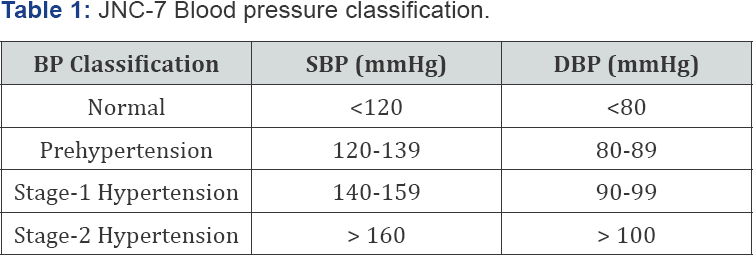
SBP: Systolic Blood Pressure, DBP: Diastolic Blood Pressure.
Age distribution of patient: The mean age (mean±S.D) of the patients was 59.28±11.0894 years with range 21-85 years and the median age was 60 years (Table 1). Test of proportion showed most of the patients 58 (38.7%) were significantly higher in the age group 51-60 years.
Weight distribution of patient: The mean weight (mean±S.D) of the patients was 61.4067±9.1917 kg with range 41-70 kg and the median was 60 kg. Test of proportion showed most of the patients 55 (36.7%) were significantly higher in the group 51-60 kg.
Gender distribution of patient: The gender ratio of the patients male: female was found to be 1.2:1. Out of the 150 studied patients, 55.3 % (83) of patients were male and 44.7 % (67) of patients were female. Test of proportion showed that the male patients were slightly more than the female patients.
Family history of patient: Test of proportion showed most of the patients were not having family history of hypertension I.e 147 (98.0%) while 3 patients (2.0%) were having family history of hypertension.
Duration of hypertension: Mean duration of hypertension (mean±S.D) in the patients was 5.4933±3.5095 and the median was 4. Test of proportion showed 86 (57.3%) patients were between 1-5 years, 51 (34%) patients were between 6-10 years and 13 (8.7%) were having history of >10 years.
Systolic blood pressure distribution in patients: The mean systolic blood pressure (mean±S.D) of the patients was 157.8067±28.3270 and the median was 152. Test of proportion showed most of the patients 73 (48.7%) were significantly higher systolic blood pressure ranging more than 160 mmHg (Table 2).
Diastolic blood pressure distribution of patients: The mean diastolic blood pressure (mean±S.D) of the patients was 93.4466±14.8461 and the median was 90. Test of proportion showed most of the patients 64 (42.7%) were significantly higher diastolic blood pressure ranging more than 100 mmHg (Table 2).

Drug therapy distribution of patients: Test of proportion showed most of the patients 142(94.7%) were on poly therapy significantly higher than mono therapy, double therapy and triple therapy 1 (0.7%), 0(0%), 7 (4.7%) respectively (Table 3).

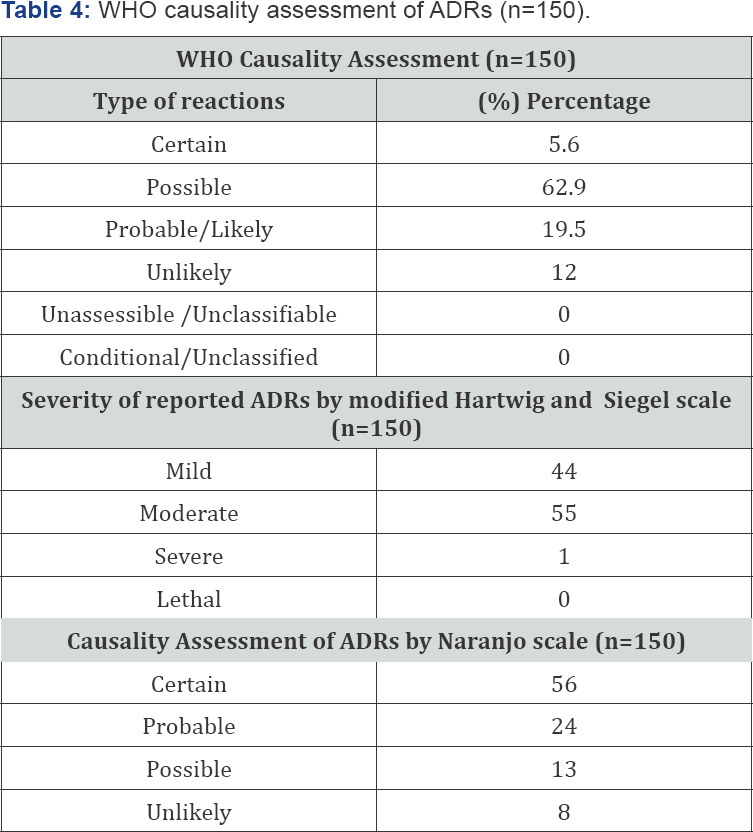
Adverse drug reactions reported: In the present study, causality assessment between the drug and suspected reaction was determined by using WHO-UMC Scale, Naranjo Scale and Hartwig and Siegel scale. According to Naranjo Criteria, the ADRs are analysed on the basis of a questionnaire comprising 10 questions in which each question is given a score of +2, +1, 0 or -1 depending on the analysis. When totaled if the score is >9 - labelled as definite ADR, if 5-8 - probable ADR, if 1-4 -possible ADR, if 0 - doubtful ADR. Among 150 patients females accounted for higher percent of ADRs (62.8%) than males (37.2%). In the study it was found that from all ADRs, reported (42.1%) were mild, (31.6%) moderate and only (26.3%) was classified as severe. Causality assessment of ADRs was done using WHO-UMC scale which categorizes ADRs as “certain”, “probable”, “possible" and “unlikely". Table 4 shows that type of reactions and their percentage are as certain (5.6 %), Possible (62.9%), Probable/ Likely (19.5%) and Unlikely (12.0 %). According to according to Naranjo scale certain (56 %), Probable (24 %), Possible (13%) and Unlikely (08%). The therapeutic classes accounting for the ADR are described in (Table 5).
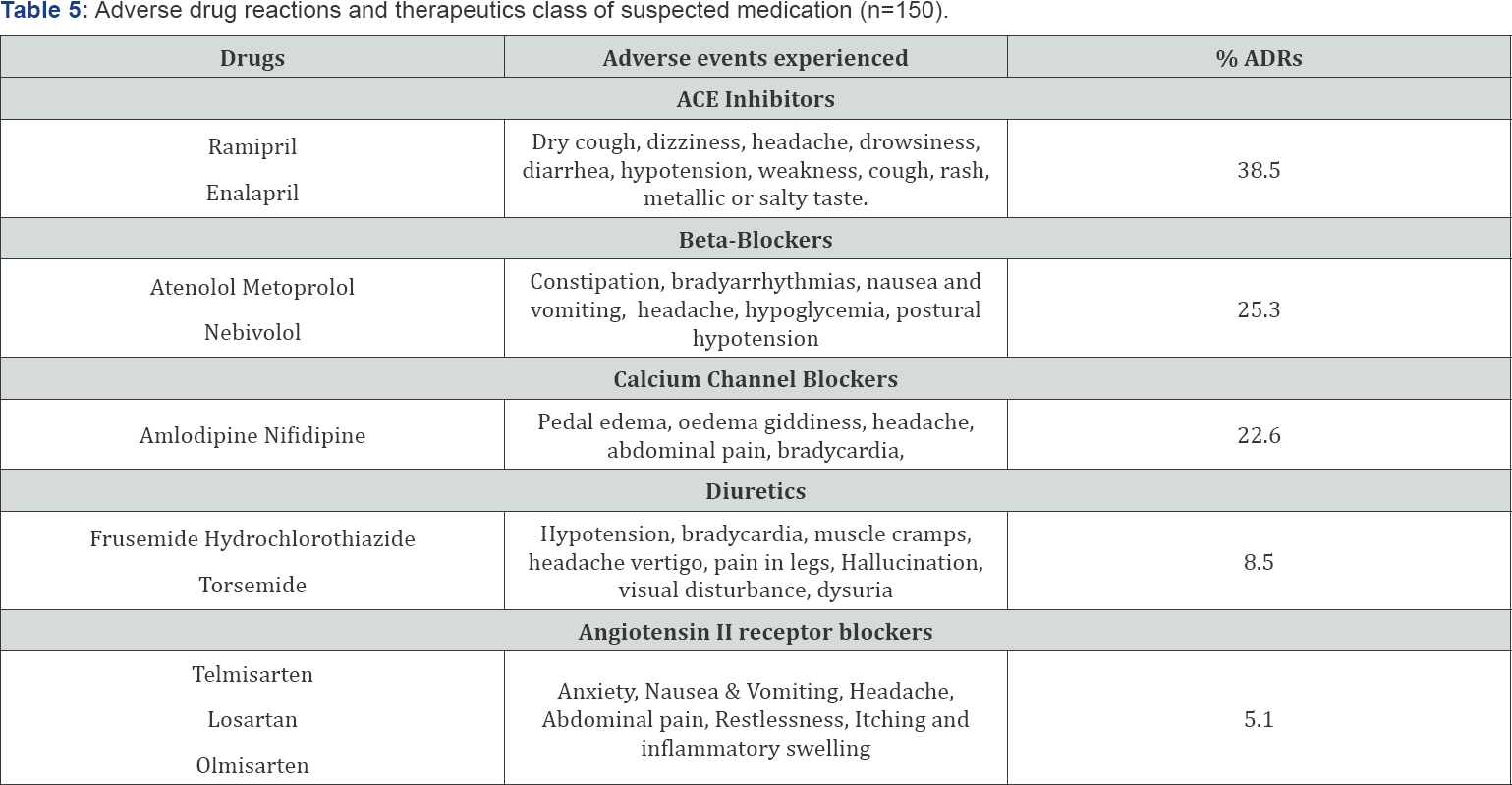
Discussion
As per the study criteria total 150 cases of hypertensive patients (Both sex) of different age group ranges from 21-70+ years were collected. After the analysis of age distribution pattern it was observed that higher no. of hypertensive patients (58) which is the 38.7% of all collected cases were falling under age group of 51-60. Plasma renin falls by 17% each decade which may be the possible reason of hypertension in older population. Our study was in consistency with study done by Brown et al. [14]. After the weight distribution analysis, it was found that the highest no. of hypertensive patient (55) was falling in the weight group of 51-60 kg which were the 36.7% of total collected cases.
Our study revel that the ratio of male: female was 1.2:1. Total hypertensive male were 83(55.3%) and total hypertensive female was 67(44.7%) of all total collected cases. The hypothetical cause of higher number of male patients is elevated levels of androgen such as testosterone as they play a role in elevation of blood pressure [15,16]. A similar study was also conducted by Reckelhoff et al., 2001 which is supporting our study.
Our study concluded that 83(55.3%) patients were illiterate whereas 67(44.7%) were literate. Education was varying from illiterate to graduation. Modification of lifestyle including reduction in dietary intake of sodium, weight loss and aerobic exercises are useful in getting desir4ed blood pressure goals so patients are needed to be educated on these non-pharmacological measures [17,18]. Williams et al., 1998 which is supporting our study.
Various observational studies of hypertension in families explore the genetic nature of hypertension by correlating the relation of elevated blood pressure also between children and parents. After family history distribution analysis, it was found that higher no. of hypertensive patients 147(98.0%) were not having family history and only 3(2.0%) patients having family history were due to carelessness of physician while writing files or patients were not interested to discuss their family history.
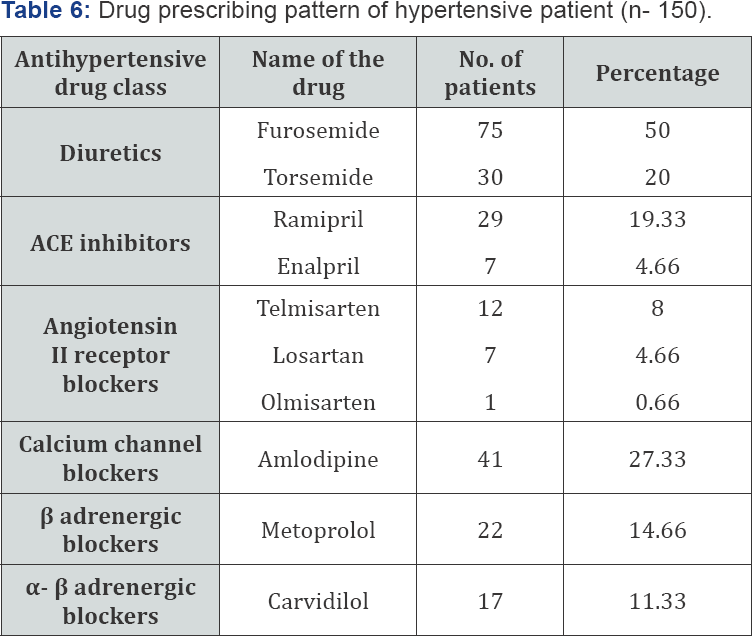
In our study 142 (94.7%) patients were on poly therapy significantly higher than mono therapy, double therapy and triple therapy 1 (0.7%), 0(0%), 7 (4.7%) respectively of all the collected cases. Our study found that following classes of antihypertensive drugs were prescribed: Diuretics, BB, ARBs, CCBs, ACEIs, alpha receptor blockers, as well as fixed drug combinations. Diuretics were prescribed the most followed by CCB's, Angiotensin Converting Enzyme Inhibitors, Angiotensin II receptor antagonists, Beta-Blockers and Alpha-Beta adrenergic blockers. First line of therapy for treating hypertension is diuretics [19]. In the present study 5.1% of diuretics were used as mono even they are of low cost. Combination of diuretics was prescribed more significantly along with ARB (63.4%) and it is as per the JNC7 and JNC 8 guidelines because diuretics plays an vital role in reduction of blood volume to normal as well as lowers the vascular resistance [20]. Our study concluded that a higher percentage of patients (56.09%) were found to be on dual therapy and among them 73(63.4%) were found to be treated with fixed dose combination i.e. ARB+ Diuretic followed by beta blockers + CCBs and the reduction of SBP and DBP was found to be significant with these combinations and the pattern is according to JNC guidelines [21] (Table 6). The most common adverse event found during the therapy with antihypertensive agents was dizziness in 28 subjects followed by nausea 14 and edema 11 patients. Overall drugs used in hypertensive patients for comorbidities are described in (Table 7). Average number of drugs prescribed per prescription was found to be 03 whereas prescriptions with generic name were 27 % and drugs from essential drug list were found to be 57 %. During the study indicators of patient care such as mean consulting time was found to be 7.8 min and availability of key drugs in the hospital was 100% (Table 8). Adherence rate of drugs prescribed as per JNC Guidelines are show in (Table 9). Total of 150 case, comorbidities were found in (60%) of patients which include congestive cardiac failure (27.5%), diabetes mellitus (11.0%), dyslipidemia (7.5%), hypertensive heart disease (7.0%), obesity (6.5%), cardiovascular disease (6.5%), and others (9.3%) comprising cerebrovascular accident, cardiomegaly left ventricular hypertrophy and bradycardia [22-29].
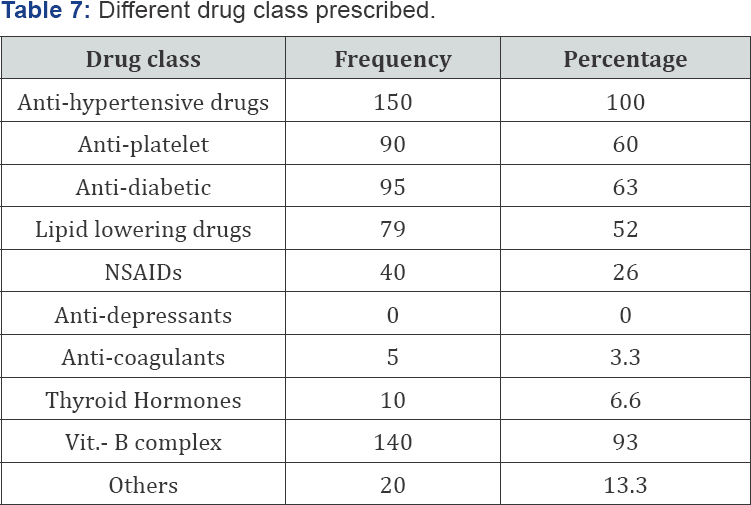

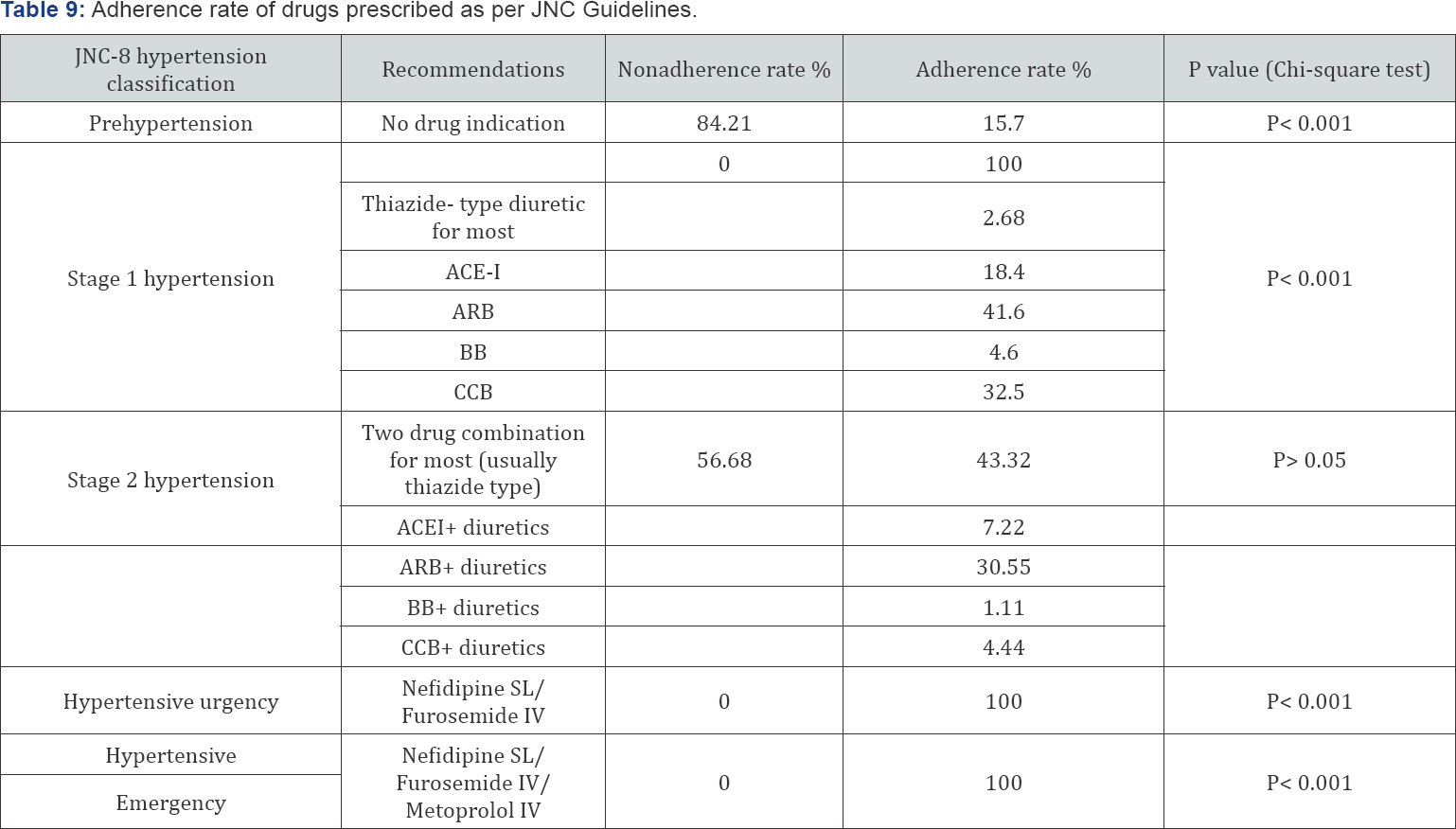
Conclusion
In our study, it was concluded that patient between age group of 51-60 years and above have a higher incidence of hypertension and among hypertensive patient's males are higher than females irrespective to heredity [30]. Most of the hypertensive patients are illiterate and unemployed and duration of the disease is less than 5 years. Among 150 hypertensive patients most common symptom shown is breathlessness. Most of hypertensive patients have co-morbid conditions; therefore, they require more than one medication for their proper treatment [31-33]. Among the comorbid conditions Diabetes mellitus were accounted the most. Among the hypertensive class, Diuretics are prescribed the most followed by CCB's, Angiotensin Converting Enzyme Inhibitors, Angiotensin II receptor antagonists, B-Blockers and A-B adrenergic blockers. Most frequent ADR found in our study was related to cardio-vascular system followed by gastrointestinal ADRs (abdominal pain, constipation and diARGHhea) [29,35-37]. Which is evidenced by report of GIT ADRs in previous studies and were among the top three ADRs? To sum up, higher number of ADRs were found in patients who were on Beta-blockers than who were on ACE inhibitor followed by CCBs. Greater risk of ADRs was found with the combinational therapy of amlodipine and atenolol followed by monotherapy which was reported earlier [13,23-28].
The knowledge and prescription of drug was concluding to be the base line idea of ADRs of antihypertensive drugs in hypertensive patients visiting OPD of tertiary teaching care hospital in India. In this study we can't say that all of the prescriptions found were rational; furthermore, more changes are needed to be done in prescription of antihypertensive drugs are needed in drug prescribing practices in hypertensive patients. Patients are needed to provide information and proper counseling regarding the ADRs of drugs; this would refine the quality of life. Keeping in mind the limitations of the current study, less time period and lesser no. of subjects included [3134].
Acknowledgement
We thank Department of Pharmacy Practice, ISF College of Pharmacy for providing support of Micromedex software for this study. The corresponding author had full access to all data in the study and had final responsibility for the decision to submit for publication.
References
- Bergman U (2006) The history of the drug utilization research group in Europe. Pharmacoepidemiol Drug Saf 15(2): 95-98.
- Sluss PM (2017) Utilization Management Initiatives That Can Be Imported into Healthcare Systems. Utilization Management in the Clinical Laboratory and Other Ancillary Services: Springer pp. 287-290.
- CARGHetero OA, Oparil S (2000) Essential hypertension. Circulation. 101(3): 329-335.
- Giles TD, Materson BJ, Cohn JN, Kostis JB (2009) Definition and classification of hypertension: an update. J Clin Hypertens (Greenwich) 11(11): 611-614.
- Mancia G, Laurent S, Agabiti-Rosei E, Ambrosioni E, Burnier M et al. (2009) Reappraisal of European guidelines on hypertension management: a European Society of Hypertension Task Force document. Blood pressure. 18(6): 308-347.
- Hyman DJ, Pavlik VN (2001) Characteristics of patients with uncontrolled hypertension in the United States. N Engl J Med 345(7): 479-486.
- Korner P (1982) Causal and homoeostatic factors in hypertension. Portland Press Limited 63(s8): 5s-26s.
- Alexander RW (1995) Hypertension and the pathogenesis of atherosclerosis. Hypertension 25(2): 155-161.
- Mancia G, Zanchetti A (1996) Editors corner: white-coat hypertension: misnomers, misconceptions and misunderstandings. What should we do next? J hypertension 14: 1049-1052.
- Bulpitt C, Palmer A, Fletcher A, Bradley IC, Broxton JS et al. (1995) Proportion of patients with isolated systolic hypertension who have burned-out diastolic hypertension. J Hum Hypertens 9(8): 675-678.
- Hirsch S (2007) A different approach to resistant hypertension. Cleve Clin J Med 74(6): 449-456.
- Gradman AH, Basile JN, Carter BL, Bakris GL, Materson BJ et al. (2010) Combination therapy in hypertension. J Am Soc Hypertens 4(2): 90-98.
- Mishra R, Kesarwani P, Keshari SS (2017) Prescription pattern of antihypertensive drugs in a tertiary care teaching hospital. International Journal of Medical Science and Public Health 6(4): 684687.
- Brown MJ (2007) Renin: friend or foe? Heart 93(9): 1026-1033.
- Svartberg J, von Muhlen D, Schirmer H, BARGHett-Connor E, Sundfjord J et al. (2004) Association of endogenous testosterone with blood pressure and left ventricular mass in men. Eur J Endocrinol 150(1): 65-71.
- Reckelhoff JF (2001) Gender differences in the regulation of blood pressure. Hypertension 37(5): 1199-1208.
- Glanz K, Kirscht JP, Rosenstock IM (1981) Linking research and practice in patient education for hypertension: patient responses to four educational interventions. Med Care 19(2): 141-152.
- Williams MV, Baker DW, Parker RM, Nurss JR (1998) Relationship of functional health literacy to patients' knowledge of their chronic disease: a study of patients with hypertension and diabetes. Arch Intern Med 158(2): 166-172.
- Krakoff LR (2005) Diuretics for hypertension. Circulation 112(10): e127-e129.
- James PA, Oparil S, Carter BL, Cushman WC, Dennison-Himmelfarb C, et al. (2014) 2014 evidence-based guideline for the management of high blood pressure in adults: report from the panel members appointed to the Eighth Joint National Committee (JNC 8). Jama 311(5): 507-520.
- Choi M, Scholl UI, Yue P, Bjorklund P, Zhao B, et al. (2011) K+ channel mutations in adrenal aldosterone-producing adenomas and hereditary hypertension. Science 331(6018): 768-772.
- Dwivedi M, Sharma A, Arora S (2015) A review on medication errors. J Pharm Technol Res Manag 3(2): 89-96.
- Sharma P, Sharma A, Gaur A, Chhabra M, Kaur R (2017) A cross sectional study on diabetes mellitus type-2 at a tertiary care hospital. Adv Res Gastroentero Hepatol 8(1): 01-06.
- Sharma A, Sharma P, Anghore D (2017) Diabetes and its complications. P. 149.
- Sharma A, Baldi A, Sharma DK, Singh R AD (2016) Fluoroquinolone (Levofloxacin) induced tendinopathy with partial tearing of the achilles tendon -A case report. J Clin Case Stud 2(6): 2-5.
- Sharma A, Baldi A, Sharma DK (2017) Drug utilization study at tertiary care hospitals in punjab. Adv Res Gastroentero Hepatol 7(5): 101-115.
- Sharma A, Baldi A, Sharma DK (2017) Drug induced generalized skin eruption in a diabetes mellitus patient receiving a metformin plus simvastatin in a tertiary care teaching hospital in Punjab. Curr Res Diabetes Obes J 4(2): 4-6.
- Sharma A, Pandit V, Kushawaha SK, Sharma DR (2014) Intensive care management of poisoning. Int J Adv Case Reports 1(1): 13-16.
- Sharma A, Vinay P (2014) Importance of poison information centre and role of a pharmacist in management of poisoning. Int J Pharm Teach Pract 5(1): 905-909.
- Sharma A, Dogra N (2014) Therapeutic drug monitoring of gentamicin: a prospective study. Int J Curr Pharm Clin Res 4(3): 139-144.
- Kushawaha SK, Sharma A, Ralta A, Sharma R, Raj D (2014) Pharmacovigilance study : Drugs used in the treatment of tuberculosis at civil hospital Rohru ( Shimla ), Himachal Pradesh. Int J Adv Case Reports 1(1): 37-41.
- Sharma A, Ghuman G (2016) Hypertension in pregnancy- an overview. World J Pharm Sci 4(6): 420-430.
- Tarlok S, Amit S, Shina P, Sourabh K, Shalini D (2015) Introduction to poisoning; A systematic review. Int J Pharm Teach Pract 6(4): 26092619.
- Anghore D, Sharma A, Singh S, Kosey S, Jindal S (2015) Treatment of snake bite in India : A Review. Int J Pharm Teach Pract 6(4): 2635-2641.
- Amit S, Hemraj, Kumar R, Kosey S, Negi N (2016) Side effects of chemotherapy and cancer treatment in tertiary care teaching hospital. Res Pharm Heal Sci 2(1): 62-78.
- Sharma A, Kushawaha SK, Anghore D, Pandit V, Sharma DR (2015) HIV / AIDS overview - Recent advancement made by WHO. Int J Pharm Teach Pract 6(1): 1582-1590.
- Sharma A, Baldi A (2015) 402 OMICS International Conference. In: Pharmaceutical Summit and Expo p.8-12.






























